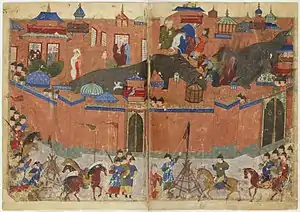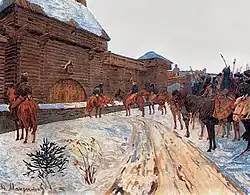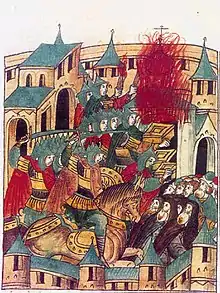Destruction under the Mongol Empire
The Mongol conquests of the 13th century resulted in widespread destruction that has been widely noted in scholarly literature. The Mongol army conquered hundreds of cities and villages and also killed millions of men, women and children. It has been estimated that approximately 11% of the world's population was killed either during or immediately after the Turco-Mongol invasions.[1] If the calculations are accurate, the events would be the deadliest acts of mass killings in human history.

Oliver Chancellor conducted research and found that the Mongol invasions induced population displacement "on a scale never seen before", particularly in Central Asia and Eastern Europe, and that "the impending arrival of the Mongol hordes spread terror and panic".[2]
Strategy
Genghis Khan, also known as Chinggis Khan and formerly known as Temujin, and his generals and successors preferred to offer their enemies the chance to surrender without resistance to avoid war, to become vassals by sending tribute, accepting Mongol residents and/or contributing troops. The Khans guaranteed protection only if those who submitted to Mongol rule were obedient.
Sources record massive destruction, terror and death if there was resistance. David Nicole notes in The Mongol Warlords that "terror and mass extermination of anyone opposing them was a well-tested Mongol tactic".[3] The alternative to submission was total war: resistance caused Mongol leaders to order the collective slaughter of populations and the destruction of property. Such was the fate of resisting Muslim communities during the invasions of the Khwarezmid Empire.

Terror
The success of Mongol tactics hinged on fear to induce capitulation of enemy populations. From the perspective of modern theories of international relations, Quester suggested, "Perhaps terrorism produced a fear that immobilized and incapacitated the forces that would have resisted."[4] Although perceived as being bloodthirsty, the Mongol strategy of "surrender or die" still recognized that conquest by capitulation was more desirable than continually being forced to expend soldiers, food, and money to fight every army and sack every place on the campaign's route.
The Mongols frequently faced states with armies and resources greater than their own. In the beginning, Temujin, the birthname of Genghis Khan, started off with a band of youths and some women, and he later had troops of 20,000 that initially faced the city states and interests of the Kin domain, which mainly included China, with then probably a 2-million-strong army, each city being populated with hundreds of thousands of inhabitants, and simply invading all of them was out of the question. Furthermore, a supine nation was more desirable than a sacked one. While both provided the same territorial gains, the former would continue to provide taxes and conscripts long after the conflict ended, but the latter would be depopulated and economically worthless once available goods and slaves were seized.
Thus, whenever possible, by using the "promise" of wholesale execution in case of resistance, Mongol forces made efficient conquests, which, in turn, allowed them to attack multiple targets and redirect soldiers and material where they were the most needed.

The reputation of guaranteed wholesale enactment on those who fought them was also the primary reason that the Mongols could hold vast territories long after their main force had moved on. Even if the tumens (tyumens) were hundreds or thousands of miles away, the conquered people would usually not dare to interfere with the token Mongol occupying force since they feared a likely Mongol return.
The linchpin of Mongol success was the widespread perception by their enemies that they were facing an insurmountable juggernaut that could be placated only by surrender. The Mongols may have counted on reports of horrifying massacres and torture to terrify their foes. The goal was to convince all that the costs of surrendering were not nearly onerous enough to risk an unwinnable war, with a guarantee of complete annihilation if they lost. That strategy was adopted partly because of the Mongols' lesser numbers. If their opponents were not sufficiently subdued, there was a greater chance they could rise again and attack the Mongols when the latter left to deal with other settlements. The Mongols thus technically covered their rear and flanks and avoided a situation in which they would have to again engage a people that had already fought and been subdued. The Mongols thus saved resources from an unnecessary second engagement.
As Mongol conquests spread, that form of psychological warfare proved effective at suppressing resistance to Mongol rule. There were tales of lone Mongol soldiers riding into surrendered villages and executing peasants at random as a test of loyalty. It was widely known that a single act of resistance would bring the entire Mongol army onto a town to obliterate its occupants. Thus, they ensured obedience through fear. Peasants frequently appear to have joined Mongol troops or to have readily accepted their demands.[5]
Demographic changes in wartorn areas
Most kingdoms resisting Mongol conquest were taken by force (some were subjected to vassaldom and not complete conquest); only skilled engineers and artisans (at the time of Khubilai Khan, doctors) were spared.
The aim was to spread terror to others. Some troops who submitted respectively overthrew or rose against their rulers were incorporated into the Mongol system to expand their manpower, which also allowed the Mongols to absorb new technology, knowledge and skills for use in military campaigns against other opponents.
Genghis Khan was, by and large, tolerant of multiple religions, but there are many cases of him and other Mongols engaging in religious war even if the populations were obedient. He passed a decree charging all Taoist followers to pay more taxes. All campaigns involved deliberate destroying places of worship.[6]
Ancient sources described Genghis Khan's conquests as wholesale destruction on an unprecedented scale in certain geographical regions, causing great demographic changes in Asia. According to the works of the Iranian historian Rashid al-Din (1247–1318), the Mongols killed more than 700,000 people in Merv and more than 1,000,000 in Nishapur. The total population of Persia may have dropped from 2,500,000 to 250,000 as a result of mass extermination and famine. Population exchanges also sometimes occurred.[7]
China reportedly suffered a drastic decline in population in the 13th and the 14th centuries. Before the Mongol invasion, Chinese dynasties reportedly had approximately 120 million inhabitants; after the conquest had been completed in 1279, the 1300 census reported roughly 60 million people. While it is tempting to attribute the major decline solely to Mongol ferocity, scholars now have mixed sentiments on the subject. The South Chinese might likely account for 40 million unregistered persons who, without passports, would not have appeared in the census. Entire peasant populations joining or enlisted for labour could result in a large population reduction because of food shortages. Scholars such as Frederick W. Mote argue that the wide drop in numbers reflects an administrative failure of records, rather than a de facto decrease, but others, such as Timothy Brook, argue that the Mongols created a system of enserfment of a huge portion of the Chinese populace, causing many to disappear from the census altogether. Other historians, like William McNeill and David Morgan, argue that the Black Death, spread by the Mongols, was the main factor behind the demographic decline in that period. The plague also spread into areas of Western Europe and Africa that the Mongols never reached. The Mongols practised biological warfare by catapulting diseased cadavers into the cities they besieged. It is believed that fleas remaining on the bodies of the cadavers may have acted as vectors to spread the Black Death.[8][9][10][11]
About half the population of Kievan Rus' may have died during the Mongol invasion of Rus. The figure refers to the area roughly corresponding to modern Ukraine.[12] Colin McEvedy (Atlas of World Population History, 1978) estimates the population of European Russia dropped from 7.5 million prior to the invasion to 7 million after it.[13]
Historians estimate that up to half of Hungary's population of two million were victims of the Mongol invasion of Europe.[14]
Destruction of culture and property
Mongol campaigns in Northern China, Central Asia, Eastern Europe and the Middle East caused extensive destruction, but there are no exact figures available for that time. The cities of Balkh, Bamiyan, Herat, Kiev, Baghdad, Nishapur, Merv, Konye-Urgench, Lahore, Ryazan, Chernigov, Vladimir and Samarkand suffered serious devastation by the Mongol armies.[15][16] For example, there is a noticeable lack of Chinese literature from the Jin dynasty, predating the Mongol conquest, and in the Siege of Baghdad (1258), libraries, books, literature, and hospitals were burned: some of the books were thrown into the river in quantities sufficient to "turn the Tigris black with ink for several days".
The Mongols' destruction of the irrigation systems of Iran and Iraq turned back millennia of effort in building irrigation and drainage infrastructure in these regions. The loss of available food as a result may have led to the death of more people from starvation in this area than the actual battle did. The Islamic civilization of the Persian Gulf region did not recover until after the Middle Ages.[17]
Foods and disease
Mongols were known to burn farmland. When they were trying to take the Ganghwa Island palaces during the at least six separate invasions of Korea under the Goryeo Dynasty, crops were burned to starve the populace. Other tactics included diverting rivers into and from cities and towns and catapulting diseased corpses over city walls to infect the population. The use of such infected bodies during the siege of Caffa is alleged by some sources to have brought the Black Death to Europe,[18] but dead bodies would likely not continue to harbour infected fleas.
Tribute in lieu of conquest
Those who agreed to pay the Mongols tribute were spared invasion and left relative independence. While populations resisting were usually annihilated and so did not pay a regular tribute, exceptions to the rule included Korea (under the Goryeo Dynasty), which finally agreed to pay regular tributes in exchange for vassaldom and some measure of autonomy as well as the retention of the ruling dynasty, further emphasizing the Mongol preference for tribute and vassals, which would serve as a somewhat regular and continuous source of income, as opposed to outright conquest and destruction.
Different tributes were taken from different cultures. For instance, Goryeo was assessed at 10,000 otter skins, 20,000 horses, 10,000 bolts of silk, clothing for soldiers, and a large number of children and artisans as slaves.[19]
Environmental impact
According to a study by the Carnegie Institution for Science's Department of Global Energy, the annihilation of so many human beings and their urban centres under Genghis Khan may have scrubbed as much as 700 million tonnes of carbon from the atmosphere by allowing forests to regrow on previously populated and cultivated land.[20][21][22]
References
- "Twentieth Century Atlas - Historical Body Count". necrometrics.com. Retrieved 2020-10-21.
- Diana Lary (2012). Chinese Migrations: The Movement of People, Goods, and Ideas over Four Millennia. Rowman & Littlefield. p. 53. ISBN 9780742567658.
- David Nicolle, The Mongol Warlords: Genghis Khan, Kublai Khan, Hulegu, Tamerlane (2004) p. 21
- George H. Quester (2003). Offense and Defense in the International System. Transaction Publishers. p. 43. ISBN 9781412829939.
- Jack Weatherford, Genghis Khan and the Making of the Modern World
- Man, John. Genghis Khan : Life, Death and Resurrection (London; New York : Bantam Press, 2004) ISBN 0-593-05044-4.
- Battuta's Travels: Part Three - Persia and Iraq Archived December 31, 2006, at the Wayback Machine
- Vincent Barras and Gilbert Greub. "History of biological warfare and bioterrorism" in Clinical Microbiology and Infection (2014) 20#6 pp 497–502.
- Andrew G. Robertson, and Laura J. Robertson. "From asps to allegations: biological warfare in history", Military medicine (1995) 160#8 pp: 369–373.
- Rakibul Hasan, "Biological Weapons: covert threats to global health security". Asian Journal of Multidisciplinary Studies (2014) 2#9 p 38. online
- "We Have Met the Enemy And They Are Small – A Brief History of Bug Warfare". Military History Now. 2014-02-07. Retrieved 26 December 2014.
- "History of Russia, Early Slavs history, Kievan Rus, Mongol invasion". Archived from the original on 2010-01-21. Retrieved 2007-10-27.
- Mongol Conquests
- Welcome to Encyclopædia Britannica's Guide to History
- Morgan, David (1986). The Mongols (Peoples of Europe). Blackwell Publishing. pp. 74–75. ISBN 0-631-17563-6.
- Ratchnevsky, Paul (1991). Genghis Khan: His Life and Legacy. Blackwell Publishing. pp. 131–133. ISBN 0-631-16785-4.
- Will and Ariel Durant. The Story of Civilization: The Age of Faith
- "Emerging Infectious Diseases journal - CDC".
- "Archived copy". Archived from the original on 2015-03-17. Retrieved 2015-02-20.CS1 maint: archived copy as title (link)
- Henley, John (2011-01-26). "Why Genghis Khan was good for the planet". The Guardian. Retrieved 2015-03-10.
- "Genghis Khan - the greenest invader in history". World Wide Fund for Nature. February 8, 2011. Retrieved December 9, 2019.
- Pappas, Stephanie (February 8, 2011). "Genghis Khan did it, but Black Plague couldn't: A look at historical events and their roles in altering carbon dioxide levels". NBC News. Retrieved May 24, 2020.
Further reading
- May, Timothy. The Mongol Conquests in World History (London: Reaktion Books, 2011) online review; excerpt and text search
- Morgan, David. The Mongols (2nd ed. 2007)
- Nicolle, David. The Mongol Warlords: Genghis Khan, Kublai Khan, Hulegu, Tamerlane (2004)
- Saunders, J. J. The History of the Mongol Conquests (2001) excerpt and text search
- Turnbull, Stephen. Genghis Khan and the Mongol Conquests 1190–1400 (2003) excerpt and text search
- Primary sources
- Rossabi, Morris. The Mongols and Global History: A Norton Documents Reader (2011),
